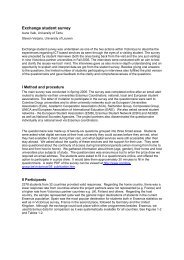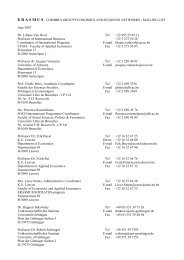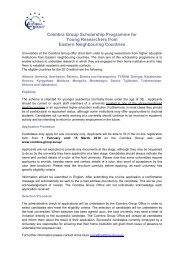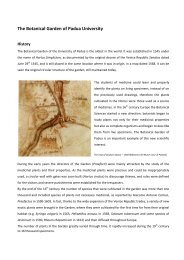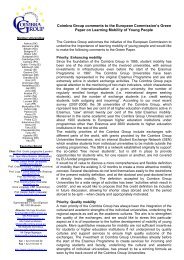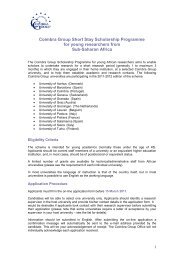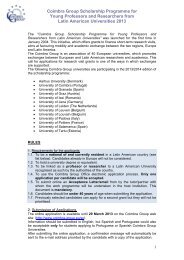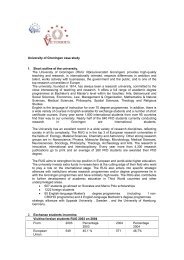You also want an ePaper? Increase the reach of your titles
YUMPU automatically turns print PDFs into web optimized ePapers that Google loves.
<strong>Uppsala</strong> <strong>University</strong> <strong>Botanic</strong> <strong>Gardens</strong>The Linnaean <strong>Gardens</strong> of <strong>Uppsala</strong>
The Linnaeus GardenA small Hortus Academicus was established in 1655 by Olof Rudbeck the elder. In thesecond half of the 17 th century he enumerates 1,800 species and cultivars in a gardencatalogue.Under the directorship of Linnaeus 1741-1778 the garden transformed and expandedconsiderably. As the site was crowded and often flooded, a new garden was needed. By theend of the 18 th century Linnaeus’ old garden was abandoned, until restored in the 1920’s toits 1750 shape.A view of the garden from 1745
The Linnaeus Garden is a text book in Linnaean botany and medicine. In this baroque stylegarden, with its strict symmetry, plant relationships, life-forms, phenology, and ecology aremade obvious.The two main parterres, one displaying annual plants and the other perennials, each have44 flower beds arranged according to Linnaeus’ sexual system. Here the 24 classes basedon stamen number and arrangement can be thoroughly investigated. Most plants in thegarden have medical properties and learning the actual plants behind the drugs wasimmensely important for the 18 th century medical student.A parterre for spring-flowering plants is found in the warmest spot of the garden, right infront of the Orangery(above) which acts like a giant reflector capturing the mid day sun. Oneof the early flowering plants is the wild tulip Tulipasylvestris, a 17 th century remnant which is foundwild all over the garden (left).In the autumn parterre Linnaeus grew his “Indian” or“Virginian” plants, i.e. plants from Eastern NorthAmerica. Here you find the coneflower Rudbeckialaciniata named by Linnaeus after the founder of thegarden, Olof Rudbeck the elder, and his son, OlofRudbeck the younger.Linnaeus designed the first ever ecologicalplantations. In the lake pond, the river pond, and the marsh pond plants are grown as intheir natural environments.The Common newt (Lissotriton vulgaris) thrives in the lake pond. Otherwise, no animals areheld in the garden today. Linnaeus, who loved animals, had for example monkeys, parrots,guinea pigs, and peacocks both for study and for company. Some, like the racoon Sjupp,became family pets.
In the Orangery Linnaeus could grow exotic plants, for example coffee and cacao. Hesucceeded in repeating his masterpiece from his Holland years by getting the banana toflower and set fruit. Nowadays the orangery is used for exhibitions, dissertation parties,weddings, etc., and the “new” Orangery (over 200 years old) in the <strong>Botanic</strong> Garden hastaken over its function.The Linnaeus Garden, today a national monument, is located close to the city centre and isopen to the public from May to September.Twin flower (Linnaea borealis), Linnaeus’ favourite flower.
<strong>Uppsala</strong> <strong>Botanic</strong> GardenThe pruned pyramids of the Baroque Garden are spruce (Picea abies), a northern substitute for the moretender Taxus. Linnaeanum with its classical façade was once built to further the linnaean sciences. Its southwing, the orangery, is the winter retreat for four Laurus nobilis trees planted by Linnaeus 250 years ago, that –together with date palms, figs, Wollemia etc. – are brought outside from May to mid-October. During this periodthe orangery is used for exhibitions of fine art.Carl Peter Thunberg, Linnaeus’ most important disciple, persuaded the king to donate thegarden of the royal palace for a new academic garden. It is today a modern botanic garden,engaged in education, research and conservation, and with an ambitious public programme.The botanic garden consists of two parts. The old palace garden has kept its strictlysymmetrical skeleton from 1660, although the exact present layout is a hundred yearsyounger, while the Linnaeanum (above and below) was completed only in 1805. Amongother features of note on the “old” side of the road dividing the garden are systematicquarters of woody plants (e. g. birch) and a pond with red water lilies.
The more recent part south of the road includes a tropical greenhouse with a collection ofSaintpaulia, including numerous threatened species, an area with economic plants frommedicine to food and rubber, and a small arboretum with wild collected trees from temperateparts of the world. Under construction (2011) are a rock garden (with rocks weighing up to15 tons!) and a phylogenetic field in the shape of a tree complete with branches and leaves.Kleinia caespitosa (left) and Aloë nugalensis from the Hornof Africa exemplify the species described as new toscience based on plants grown in our garden [cactus house]The Asian Arisaema fimbriatum teaches ourkids and students that some plants deceivetheir pollinators – in this case female flieslooking for places to lay their eggs[tropical greenhouse]The South American Heliconia rostrata(left) demonstrates a typical hummingbirdsyndrome, whereas the Indian Thunbergiamysorensis is pollinated by sunbirds.[tropical greenhouse]<strong>Uppsala</strong> <strong>Botanic</strong> Garden is located just west of <strong>Uppsala</strong> palace, and is, including the tropicalgreenhouse, open to the public all year.
The Asiatic peat hill boasts a unique collection ofCorydalis. Discovered in 2007, C. anthocrene(China: Sichuan) is yet only known from twoindividuals (above)Orobanche is a flowering plant genus parasitisingother flowering plants, in this case O. lucorum onBerberis(right).ByblisAkebia quinata
Linnaeus’ HammarbyLinnaeus’ summerhouse Hammarby is one of the best preserved 18 th century houses inSweden and is today a popular recreation spot as well as a historic monument, a sanctuaryfor surviving linnaean plant clones and a place for contemplation and education.The manor house at Linnaeus’ Hammarby with Siberian crab apple (Malus baccata) in flower.Nowhere will you get closer to Linnaeus than on his beloved Hammarby. Entering his houseyou step right into Linnaeus’ realm of scientific work and net working as well as his privatesphere. Each spring a flowering Siberian crab apple tree on the court yard welcomes visitorsand from Linnaeus’ study St Lucy’s cherry can be admired. For two and a half century theflowering of these trees planted by Linnaeus have announced summer, the seasonLinnaeus and his family loved to spend at Hammarby.Already a world famous natural historian and a renowned professor of medicine he boughtthe estate in 1758. He needed a place to escape the unhealthy environment of <strong>Uppsala</strong> andto secure the subsistence of his wife and five children if he were to die.Still today we can admire his summer house and garden. Visitors can easily picture bothLinnaeus’ scientific work and family life. Linnaeus decorated his study and bedroom with thethings he cherished: his beloved plants, literally stuck to the walls, interesting animals, hiscoat of arms, as well as portraits of family members and patrons. Standing in his study byhis desk you get the feeling that Linnaeus only just left the room, perhaps teaching studentsin the garden, and soon will come back.
Apart from the two trees mentioned initially, there are about forty plant species fromLinnaeus’ days still surviving at Hammarby. The scopolia is restricted to its presumablyoriginal spot while dog’s mercury is spreading all over the area..The henbane bell (Scopolia carniolica), one of the fortyLinnaean plants at HammarbyThe martagon lily (Lilium martagon) is a Linnaeanplant which is found in plenty at HammarbyBeing able to actually study the sameplant individuals or clones as Linnaeusdid is of great importance. Doing it in agenuine 18 th century environment is ofextra value. To enhance the experienceeven further, the surroundinglandscape is since 2007 a culturalreserve managed by 18 th centurymethods.On the hill behind the manor housethere is a small yellow stone house.This is Linnaeus’ natural historymuseum – his museum in altis, hiscastle in the air. After several fires,Linnaeus realised that his herbariumspecimens and his vast collections ofanimals in alcohol, insects, minerals,etc. were in danger. A fire proofmuseum was built in a fortnight. Theopening was celebrated and the crownprince paid a visit.The manor house at Linnaeus’ Hammarby withSt Lucy’s cherry (Prunus mahaleb) in flower.
The same prince was as king not visited by the immensely rich Lord Baltimore. The Lordhad no interest in meeting royalties but came to Sweden to meet the Floral King. And peoplecontinue to come to Hammarby. Whether they are interested in the life and work ofLinnaeus, cultural history, science, gardens, the country side or just to rest a while with acup of coffee, Hammarby will do the job.The manor house in FebruaryLinnaeus’ Hammarby is situated 15 km SE of the city centre. It is open from May toSeptember and is most easily reached by bicycle or car.LinnéträdgårdenSvartbäcksgatan 27; +46 18 471 25 76www.linnaeus.uu.se<strong>Uppsala</strong> botaniska trädgårdVillavägen 8; +46 18 471 28 38www.botan.uu.seLinnés Hammarby59° 49’ 3’’ N, 17° 46’ 35’’ E+46 18 32 60 94www.hammarby.uu.se




